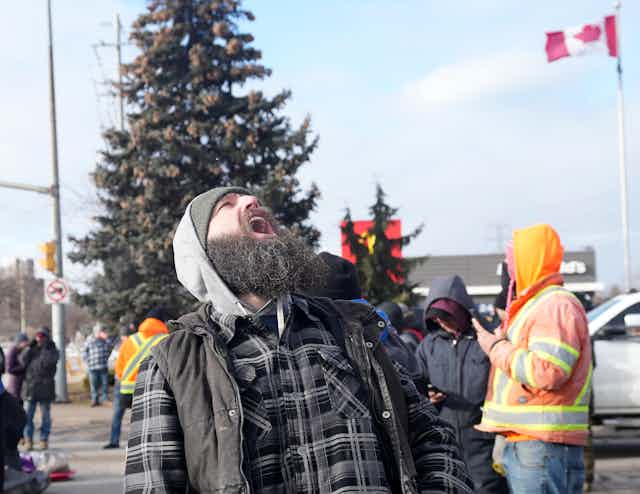It’s clear the so-called “freedom convoy” is speaking to something much bigger than vaccine mandates.
The convoy has been big news in the American media. The fact that high-profile politicians in the United States, including Donald Trump, Ted Cruz and Ron DeSantis, have weighed in on the crisis is revealing in and of itself. There were already serious concerns about the extreme divisions in American society and the ways in which these leaders, among others, have exploited and escalated similar tensions for their own personal gain.
Read more: Politics of resentment on full display at GOP debate
Some Canadian politicians, it seems, are working from the same playbook and, in so doing, taking the same risks. Pierre Poilievre, the current frontrunner for the Conservative Party of Canada leadership race, has clearly drawn on the language of the protest in a pinned tweet aimed at galvanizing support for his leadership run.
Regardless of political rhetoric, it’s overwhelmingly clear that this protest is not about truckers or vaccines.
Rather it’s about what American sociologist Michael Kimmel refers to as “aggrieved entitlement” — a perception that the benefits and/or status you believe yourself entitled to have been wrongfully taken away from you by unforeseen forces. This perception can lead to feelings of humiliation and, in turn, violence.
In a textbook-worthy example of “aggrieved entitlement,” the organizers of the convoy protest, most of whom aren’t employed in the trucking industry, seized on the trucker vaccine mandate to mobilize those Canadians already angry and mistrustful about the direction of our society.
Read more: The police, not the military, must stop the 'freedom convoy' and Canada's far-right uprising
Change is viewed as threatening
We are witnessing a real-time manifestation of the anxiety, fear, anger and resentment some Canadians are experiencing in response to various changes in the social order — changes they interpret as threats to their social status, particularly relating to gender and race.
This emotional sense of the world as threatening best explains the who, what, why and how of the convoy protest. This unifying motivation to destabilize the current social order is the latest and most significant indication that Canadian politics is changing dramatically. Growing western alienation could be one signal that Canada is becoming increasingly polarized.
Read more: Canadian populism got shut out this election — but it's still a growing movement
The implications are twofold. First, we may be witnessing a shift in attitudes away from a moderate political centre and towards more extreme positions among an increasing number of citizens. Second, this shift may not be driven by policy disagreements but rather emotions and feelings about the world around us.

Should we be worried about these trends? Absolutely. The perception that someone’s status in society is threatened can have a significant impact. This trend likely best explains the 2016 election of Donald Trump and the subsequent events leading up to and including the Jan. 6, 2021, insurrection at the U.S. Capitol following his defeat in 2020.
Despite much political rhetoric and media framing to the contrary , the gap in voting behaviour between whites with college education and uneducated whites isn’t explained well by economic differences or anxieties, but is instead best explained as the outcome of sexism and racism.
American political communications scholar Diana Mutz has documented overwhelming evidence that the central motivation behind Trump support was a perception of a status threat among dominant or “high-status” groups that fall into one or more of the following categories: white, Christian and male.
The far right is part of the convoy
The “freedom convoy” is comprised of protesters likely to mobilize under the alt-right banner. As Evan Balgord, executive director of the Canadian Anti-Hate Network, observes, the convoy protest has always been “inextricably tied to Canadian far-right groups, including members of radical, neo-Nazi-linked ‘accelerationist’ networks, Holocaust deniers and supporters of the white nationalist Great Replacement theory.”
That’s why it’s not surprising the messaging goes far beyond vaccine mandates and includes overt symbols of racism such as swastikas and Confederate flags. It’s also funded at least in part by what observers have labelled “rage donating.”
The alt-right base is also why the demands are so grandiose, including the call to meet with the governor general and to build a coalition to defeat the sitting government. While these calls have no basis in how government works, it’s the emotional connection some Canadians seemingly have to these calls that is most worrying and most worthy of careful consideration on how to move forward.

To mitigate and reduce these divisions, leaders must walk a fine line, balancing the need to acknowledge and recognize these sentiments while offering alternative, more unifying messages and opportunities to bring citizens together.
Unfortunately, both the federal and Ontario governments failed to do this early on, and we now have the first invocation of the Emergencies Act since it replaced the War Measures Act in 1988. This invocation marks a sombre and foreboding milestone in the history of Canadian democracy.

